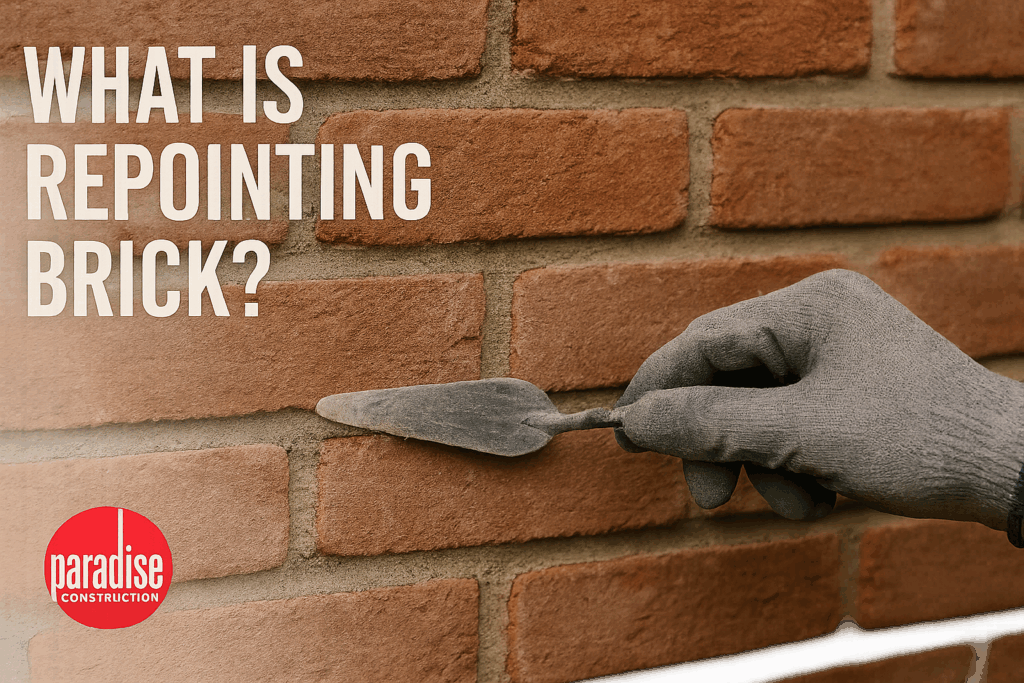If you’ve ever walked past an old brick wall and noticed gaps or crumbling bits between the bricks, you’ve probably seen a job that needs repointing. Now, what is repointing brick exactly? It’s the process of renewing the outer portion of the mortar joints in masonry construction. In simpler terms, it’s removing old, damaged mortar from between bricks and replacing it with new mortar.
So, yeah, it might not sound super exciting at first. But pointing brickwork is more important than most folks think. It helps maintain the wall’s strength, protects it from water damage, and can even improve how the whole structure looks. If left untouched, that cracked or missing mortar can cause bricks to loosen and water to seep into places you don’t want it. Which, let’s be honest, can become a big mess over time.
What Does Repointing Brick Mean?
When someone asks, “What does repointing brick mean?” it’s basically about maintenance. The word “repointing” can be a bit confusing. People sometimes mix it up with tuckpointing or just think it means painting bricks (which it doesn’t). In truth, repointing bricks is just about fixing the mortar, not the bricks themselves.
Over time, weather and age wear down the mortar that holds bricks together. This happens faster in areas with freeze-thaw cycles, where water gets into the joints, freezes, expands, and breaks things apart. That’s where brick repointing comes in. By scraping out the damaged mortar and filling it in with fresh material, you stop the cycle and give the structure a new lease of life.
How to Repoint Bricks?
Learning how to repoint bricks might seem like something only a professional mason can do. And while experts have the right tools and experience to repair bricks in masonry. Here’s the simplified version of what the process looks like:
- Check the condition: First, inspect the wall. Look for gaps, cracks, or flaking mortar.
- Remove old mortar: Use a grinder or chisel to take out around 1/2 to 3/4 inches of mortar from between the bricks. Be careful not to damage the bricks themselves.
- Clean the joints: You’ll need to brush out any dust and debris.
- Mix new mortar: Try to match the color and type of the existing mortar. This part matters a lot if you want it to blend in.
- Apply the new mortar: Using a pointing trowel, push the mortar into the gaps and press it in firmly.
- Finish and cure: Shape the joint, clean any extra mortar off the bricks, and keep it moist for a few days so it cures right.
What mistakes do people make here? They rush through it. Brick-pointing isn’t a race. If it’s not done right, the new mortar won’t bond well, and it’ll just start cracking again.
Brick Pointing vs Brick Repointing?
Let’s clear something up. What is brick pointing? And is it different from repointing brick? Technically, yes. Brick pointing services refer to the original mortar application when the wall was first built. Whereas, brick repointing services are needed when you remove and replace the mortar years later.
The two terms often get used interchangeably, especially online or by homeowners, but pros usually keep that difference in mind. So, if someone says they’re pointing to brickwork, they might mean they’re building something new. If they say repointing brickwork, it means they’re fixing what’s already there.
Why Repointing Brick Foundation Shouldn’t Be Ignored?
Now, let’s talk about the foundation. Repointing brick foundation walls is arguably more important than the decorative parts up top. That’s because your entire house rests on that base. If moisture gets in or the mortar crumbles away, the foundation can shift, sink, or even crack. That’s a huge safety issue.
A lot of older homes with brick basements or crawl spaces end up needing this kind of work. If you see powdery white stuff on the wall (called efflorescence), cracks near the floor, or water getting through the walls, it’s probably time to call in someone to look at your foundation mortar.
When Is the Right Time for Repointing Brickwork?
Timing matters. Don’t wait until bricks are falling out or the wall is leaning. The best time to catch it is when the mortar starts looking dry and flaking, or when small cracks show up between the bricks. Once the damage gets deeper, it’s not just about repointing anymore, you might need to replace bricks or even sections of the wall.
And by the way, weather counts too. It’s not a great idea to repoint bricks in the middle of winter or on a super rainy day. Mild, dry weather gives mortar the best chance to set properly.
Hire A Professional To Repoint Bricks
Honestly, repointing brick is a mix of art and science. Matching mortar color and texture, shaping joints properly, and knowing how deep to go all take practice. So it is recommended to hire a professional like Paradise Construction. They have completed more than 1500 projects, with 1300+ satisfied customers, and their job is done!
You can reach Paradise Construction to book your appointment by calling them at +1 718-238-9191
